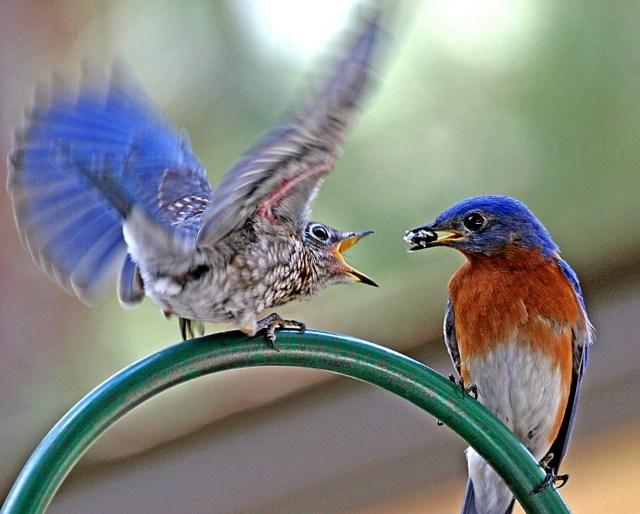June Nature Happenings
• As the month progresses, feeders can become busy with visiting parents and fledglings. Watch for fledgling birds calling for food and quivering their wings at your feeders.
• Many bird species are into their second broods. Once a bird has finished nesting with all young fledglings gone from the nest, clean out the nest box thoroughly for another brood. Cleaning will insure a healthy second brood with greater survival capabilities for the nestlings.
• Still time to place another nesting box as many species are continuing breeding late into July.
• Eastern Kingbirds have returned from South America. Watch them aggressively defending their nesting sites.
• House Wrens, “Jenny Wrens”, are beginning to nest. They are the noisiest birds to have in your backyard, continuously singing morning-to-night. They are an annoyance to some, but cherished by many.
• Look for birds like Cedar Waxwings, Catbirds and Orioles eating ripe fruit, they especially love oranges and grape jelly as well as trees with berries in your backyard.
• Egg-laying begins for Baltimore Orioles, Rose-breasted Grosbeaks and Ruby-throated Hummingbirds
• Wood Duck and Mallard ducklings hatch and venture forth early in the month.
• Canada Geese begin molting, mid-June through early July. During this time, they cannot fly.
• Living on the edge of a mature forest woodlot? Keep your eyes open for Scarlet Tanagers nesting in the tops of mature trees.
• Bird migration is finished. Birds that are here now are summer residents that nest.
• Birds with access to backyard feeders benefit greatly from their ability to spend less time foraging for food and more time engaging in activities that enhance their health, safety, and reproduction.
• Offer a birdbath or fountain if you don't have a source of water on your property.
• June bugs collect around porch lights at night.
• Japanese Beetles will begin to appear around the middle to end of the month.
• Bagworms will begin to appear around the middle to end of the month.
• Bats are active at night; get your bat houses up.
• Firefly's are flashing in the early evening.
• Black Bears begin breeding now through July.
• White-tailed Deer fawns continue to be born through mid-month.
• Young woodchucks and raccoons emerge and venture out with their mothers.
• Horseshoe Crabs spawn on Chesapeake beaches in late-May to early-June.
• Pond turtles are digging nests; the eggs will hatch in 80 – 90 days.
• Crickets begin their nightly serenade.
• Coreopsis and Butterfly Weed start blooming; they're great butterfly attractors.
• Trumpet Vine starts blooming; it's a great hummingbird attractor.
SPECIAL DATES
• June 4, Mercury will be visible right after sunset, look for it in the western sky.
• June 5, Full Moon, also known as the "Strawberry Moon" for the Algonquin Indians, because of the short strawberry season during June. However, the settlers from Europe called this full moon the "Rose Moon" or the "Honey Moon".
• June 5, World Environment Day. Go to: https://www.worldenvironmentday.global/
• June 6-7, North Carolina Black Bear Festival, Plymouth, NC. Go to: https://www.ncbearfest.com/
• June 20, First day of summer (Summer Solstice) in the Northern Hemisphere. Headed to Australia? This will be the first day of winter (Winter Solstice) in the Southern Hemisphere.
• June 21, New Moon
• June 21, FATHERS DAY! Check out all the best Avian Fathers at: https://winchester.wbu.com/best-bird-dad
INTERESTING HISTORICAL DATES
• June 5, 1995, A pair of “love-sick” Flickers excavate over 200 holes in the fuel tank insulation of the space shuttle Discovery resulting in a launch delay that cost over $1 million.
• June 6, 1934, Donald Duck, America’s favorite duck, appears in Disney’s The Wise Little Hen.
• June 9, 1931, Birthdate of Phoebe Snetsinger author of “Birding on Borrowed Time” and documenter of over 8398 species of birds.
• June 11, 1910, Birthdate of Jacques-yues Cousteau, French explorer and conservationist.
• June 17, 1987, the last Dusky Seaside Sparrow dies. The species declared extinct in 1990.
• June 28, 2007, the Bald Eagle is officially removed from the EPA Threaten Species list.


